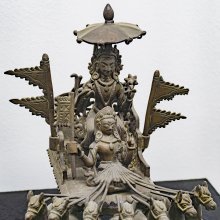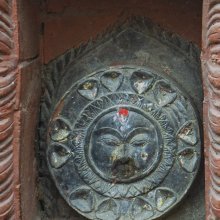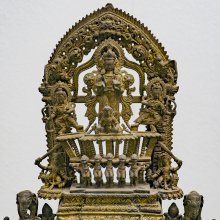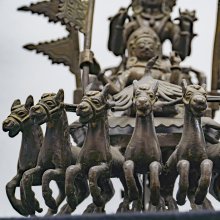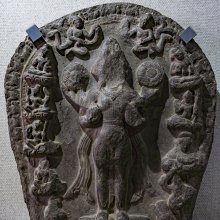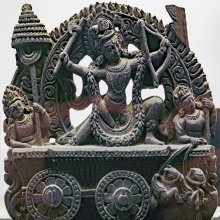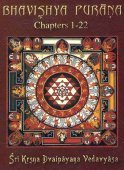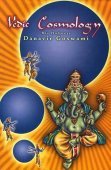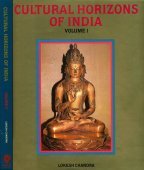Surya, Sūrya, Sūryā, Shurya: 61 definitions
Introduction:
Surya means something in Buddhism, Pali, Hinduism, Sanskrit, Jainism, Prakrit, the history of ancient India, Marathi, Hindi. If you want to know the exact meaning, history, etymology or English translation of this term then check out the descriptions on this page. Add your comment or reference to a book if you want to contribute to this summary article.
Alternative spellings of this word include Sury.
Images (photo gallery)
(+37 more images available)
In Hinduism
Natyashastra (theatrics and dramaturgy)
Source: Wisdom Library: Nāṭya-śāstraSūrya (सूर्य) is the Sanskrit name for a deity to be worshipped during raṅgapūjā, according to the Nāṭyaśāstra 3.1-8. Accordingly, the master of the dramatic art who has been initiated for the purpose shall consecrate the playhouse after he has made obeisance (e.g., to Sūrya).
Source: archive.org: The mirror of gesture (abhinaya-darpana)One of the Nava-graha (Hands that indicate the Nine Planets).—Sūrya: Solapadma and Kapittha hands held on the shoulders.
Source: Shodhganga: The significance of the mūla-beras (natya)Sūrya (सूर्य) refers to the sun, which can de depicted using hand gestures (hasta or mudrā).—In dance, when the left hand assumes alapadma-hasta above the head and the right hand is in kapittha-hasta near the right shoulder, it is considered sūrya-hasta.
There are four more depictions of the sun (sūrya):
- udaya-sūrya (rising sun),
- madhyāna-sūrya (hot sun at noon),
- astamaya-sūrya (setting sun),
- sāya-sūrya (evening sun),
If the dancer wants to depict the udaya-sūrya (rising sun), then two kaṭakāmukha-hastas are to be held on the right and the left sides of the shoulder in sama-sthānaka posture. The look is peaceful. If the madhyāna-sūrya (hot sun at noon) is depicted, then sūcī-hasta is held in front of the chest and then raised above the forehead. The expression is anger and cruel look and the leg posture is sama-sthānaka. If it is the astamaya (setting) or sāyam-sūrya (evening sun), then both the hands assume kaṭakāmukha-hastas. The sidelong look is directed downwards in sama sthānaka.

Natyashastra (नाट्यशास्त्र, nāṭyaśāstra) refers to both the ancient Indian tradition (shastra) of performing arts, (natya—theatrics, drama, dance, music), as well as the name of a Sanskrit work dealing with these subjects. It also teaches the rules for composing Dramatic plays (nataka), construction and performance of Theater, and Poetic works (kavya).
Jyotisha (astronomy and astrology)
Source: Wisdom Library: JyotiṣaSūrya (सूर्य) refers to the sun, which is also known as ravi, bhānu or āditya, amonst others. The corresponding day of the week is sunday (bhānuvāra). The term is used throughout Jyotiṣa literature.
Source: Wisdom Library: Brihat Samhita by VarahamihiraSūrya (सूर्य) [=Saura?] is the name of an author of Astronomical texts, according to the Bṛhatsaṃhitā (chapter 2), an encyclopedic Sanskrit work written by Varāhamihira mainly focusing on the science of ancient Indian astronomy astronomy (Jyotiṣa).—Accordingly, “We shall now proceed to give a brief description of (the qualifications of) a jyotiṣaka. [...] He must have studied the works of Pauliśa, Romaka, Vasiṣṭha, Sūrya and Pitāmaha; he must have a correct, knowledge of a yuga (43,20,000 Solar years), [...]”.
Source: Prabhupada Books: Sri Caitanya Caritamrta (jyotisha)Sūrya (सूर्य) refers to the “sun”, as mentioned in the Śrī Caitanya Caritāmṛta 2.20.387ff.—Accordingly, “The sun [i.e., sūrya] moves across the zodiac day and night and crosses the oceans between the seven islands one after the other. According to Vedic astronomical calculations, the rotation of the sun consists of sixty daṇḍas, and it is divided into thirty-six hundred palas. The sun rises in steps consisting of sixty palas. Sixty palas equal one daṇḍa, and eight daṇḍas comprise one prahara. The day and the night are divided into eight praharas—four belonging to the day and four belonging to the night. After eight praharas, the sun rises again”.

Jyotisha (ज्योतिष, jyotiṣa or jyotish) refers to ‘astronomy’ or “Vedic astrology” and represents the fifth of the six Vedangas (additional sciences to be studied along with the Vedas). Jyotisha concerns itself with the study and prediction of the movements of celestial bodies, in order to calculate the auspicious time for rituals and ceremonies.
Purana and Itihasa (epic history)
Source: archive.org: Puranic Encyclopedia1) Sūrya (सूर्य).—The God who gives light to the worlds. Birth. It is said that the Sun was born to Kaśyapa by his wife Aditi. Mahāviṣṇu begot Brahmā and Brahmā begot Marīci. Prajāpati Kaśyapa was born from Marīci. Several sons were born to Kaśyapa by Aditi the daughter of Dakṣa. They are known by the names Ādityas, Vasus, Rudras and so on. Of these, Ādityas are tewelve in number. (Āditya means the son of Aditi). There is a difference of opinion as to who these twelve Ādityas are. According to Agni Purāṇa, Chapter 51, the twelve Ādityas are Varuṇa, Sūrya (the Sun), Sahasrāṃśu, Dhātā, Tapana, Savitā, Gabhasti, Ravi, Parjanya, Tvaṣṭā, Mitra and Viṣṇu. (See under Dvādaśādityas). But in Mahābhārata, Ādi Parva, Chapter 65, Stanza 15, it is stated that the twelve Ādityas are Dhātā, Aryamā, Mitra, Śukra, Varuṇa, Aṃśa, Bhaga, Vivasvān, Pūṣā, Savitā Tvaṣṭā and Viṣṇu. (See full article at Story of Sūrya from the Puranic encyclopaedia by Vettam Mani)
2) Sūrya (सूर्य).—An asura (demon). It is stated in Mahābhārata, Ādi Parva, Chapter 65, Verse 26, that this asura was the son born to Prajāpati Kaśyapa by his wife Kadrū. The King Darda was the rebirth of this asura.
Source: Cologne Digital Sanskrit Dictionaries: The Purana Index1a) Sūrya (सूर्य).—Is Mārtāṇḍa as he occupies the inanimate globe; is Hiraṇyagarbha being born of the Golden Egg. By his course are divided all the worlds: the Lord of all, animate and inanimate: His movement among the rāśīs in the sky. Traversing the signs of Meṣa and Tulā (the Goat and Balance) he makes days and nights of equal length: traversing the five signs commencing with Vṛṣabha (Bull) he makes days longer and nights shorter in a month by 24 minutes: traversing the five signs commencing with Vṛścika, he reverses the process. Rides in a chariot of one wheel with Aruṇa as charioteer. Sixtythousand Vālakhilyas go in front of him singing the Vedas: is also served by other sages, Gandharvas, Apsaras, Nāgas, Yakṣas, Yātudhānas, and Gods;1 the sun moves with Meru and Dhruva on his right and marches towards the signs of the Zodiac. The twelve signs are the twelve months of a year. If he traverses one-sixth of the orbit, it is Ṛtu, and if he completes one-half of his heavenly path it is ayana. Sometimes the velocity is slow, sometimes rapid and moderate: the name of the year differs accordingly.2 also known as Divaspati and Divākara; 100 thousand yojanas from the earth, and the same distance from moon;3 does not shine in Ilāvṛtam;4 protects the earth and hence Ravi;5 cosmology of; sunrise at Samyamana, midday at Amarāvatī; evening for Vibhā and midnight for Sukhā. His rays enter fire during nights and come back during mornings; hence waters are warm during nights and cool during days; in a muhūrta Sūrya spreads over a lakh and 81,000 yojanas;6 chariot of one wheel with vedic metres as horses; colour of the sun in six seasons different; parent of the worlds, all birth and devastation due to him.7 Twelve-fold ātma; instructed Yājñavalkya in the form of a horse the yajus;8 father of the Yuvati class of Apsaras; a friend of king Satrājit.9 Relative size of sun, moon, etc.; relative splendours, motions and qualities; different classes of rays named;10 survives antara pralaya; came after Brahmā in the order of creation;11 Śrāddha deva;12 Sunday sacred to:13 fight with Kālanemi.14
- 1) Bhāgavata-purāṇa V. 20. 43-6; 21 (whole).
- 2) Ib. 22. 1-7.
- 3) Brahmāṇḍa-purāṇa IV. 2. 20, 29.
- 4) Ib. II. 17. 10.
- 5) Ib. II. 20. 58; Ch. 21.
- 6) Ib. II. Ch. 22-3; Matsya-purāṇa Ch. 128.
- 7) Brahmāṇḍa-purāṇa II. Ch. 24.
- 8) Ib. II. 35. 23-5.
- 9) Ib. III. 7. 21, 215; 71. 21, 29.
- 10) Matsya-purāṇa Ch. 128. 13-74.
- 11) Ib. 2. 12 and 31.
- 12) Ib. 13. 1.
- 13) Ib. 70. 33.
- 14) Ib. 150. 151-179; 268. 11.
1b) A son of Kaśyapa and Aditi; wives Samjñā and Chāyā; father of Manu, Śrāddhadeva and Yama and Yami; see Vivasvan.1 Presented Pṛthu with arrows from h{??} rays; worship of: in Plakṣadvīpa,2 begot a son on Pṛthā, still a maiden;3 presented his friend Satrājita with Syamantaka (s.v.);4 propitiated by Yājñavalkya, imparted to him vājasamyaṣṭa yajus in the form of a horse.5 Pointed out with Soma, Rāhu in deva's disguise. Hence Rāhu chases him in parvas. Fought with Bāṇa in Devāsura war;6 Baḍavā was another wife, and Tapati daughter;7 is Vibhāvasu ten Kalas of;8 gives life to Agni.9 (Āditya): came to Kārtavīrya Arjuna in Brahman's disguise and asked for a gift of all sthāvara for his food and offered in turn bows ever effulgent to help in burning down all sthāvaras;10 māhātmya of, in the Bhaviṣya;11 the day sacred to the sun is the one when Hastam and Saptami fall on the same day;12 is Rāhu's abode;13 knows what Śiva did to Pūṣa and Bhaga;14 through Sarasvatī, got his two sons (not named);15 worship of, by Brahmans.16
- 1) Bhāgavata-purāṇa VI. 6. 39-41; IX. 1. 10-11.
- 2) Ib. V. 15. 18; 20. 4-5.
- 3) Ib. IX. 24. 32. 5.
- 4) Ib. X. 56. 3.
- 5) Ib. XII. 6. 66-74.
- 6) Ib. VIII. 9; 24-6; 10 30.
- 7) Ib. VIII. 13. 8-10; IX. 22. 4.
- 8) Brahmāṇḍa-purāṇa I. 21. 83.
- 9) Ib. IV. 35. 81-3.
- 10) Matsya-purāṇa 2. 31; 44. 3-11.
- 11) Ib. 53. 31.
- 12) Ib. 5. 4.
- 13) Ib. 127. 10.
- 14) Ib. 155. 7.
- 15) Ib. 171. 57-8.
- 16) Ib. 184. 31.
1c) A son of Bali; a Dānava.*
- * Matsya-purāṇa 6. 11; Brahmāṇḍa-purāṇa III. 6. 8.
1d) See Ādityas.*
- * Viṣṇu-purāṇa V. 1. 58.
2) Sūryā (सूर्या).—A daughter of Kālindī.*
- * Bhāgavata-purāṇa X. 58. 20.
Sūrya (सूर्य, “sun”).—The story of Sūrya, the sun god, is as follows. Twelve sons were born to sage Kaśyapa and his wife Aditi. Each one has a different name and his own family. Each son presides over one month in a year. Saṃjñā, Chāyā, Ikṣubhā and Rājñī are the names of Sūrya's queens. The first two are more known in the south.
Seven chandas or meters came to serve him as horses. They are namely
- Gāyatrī,
- Ūṣṇik (Uṣṇih),
- Anuṣṭubh,
- Bṛhatī,
- Paṅkti,
- Triṣṭubh
- and Jagatī.
They also represent the seven days. The chariot must have only one wheel with either twelve or six spokes. In case the spokes are six, they represent the six seasons like Vasanta, Grīṣma etc. and if they are twelve, they are the months.
Source: JatLand: List of Mahabharata people and placesSūrya (सूर्य) is a name mentioned in the Mahābhārata (cf. I.59.26, I.65, IX.44.4, IX.44.28) and represents one of the many proper names used for people and places. Note: The Mahābhārata (mentioning Sūrya) is a Sanskrit epic poem consisting of 100,000 ślokas (metrical verses) and is over 2000 years old.
Source: Shodhganga: The saurapurana - a critical studySūrya (सूर्य) refers to the “sun”, and is identified with Śiva, according to the 10th century Saurapurāṇa: one of the various Upapurāṇas depicting Śaivism.—Accordingly, the Saurapurāṇa which is purely a Śaivite work, though it purports to be revealed by the Sun, contains some references to practices of Saura Sects, and here and there it identifies Śiva with the Sun. From the eulogy of the Sun by Manu it appears that the sun is the Supreme deity. He is Trimūrti, Triguṇa, Haṃsa, Śiva, Hari, Brahmā, Paramātman, Oṃkāra, Vaṣaṭkāra, the cause of the origin of the Universe etc. In another passage Manu while eulogizing the Sun god expresses that the Sun is another form of Lord Śiva. The sun is also stated to be Ambikāpati, Īśāna, Jaṭila, Rudra, Śiva etc.

The Purana (पुराण, purāṇas) refers to Sanskrit literature preserving ancient India’s vast cultural history, including historical legends, religious ceremonies, various arts and sciences. The eighteen mahapuranas total over 400,000 shlokas (metrical couplets) and date to at least several centuries BCE.
Vastushastra (architecture)
Source: Wisdom Library: Vāstu-śāstraSūrya (सूर्य, “sunday”) corresponds with the sun and refers to the first of seven vāra (days), according to the Mānasāra. It is also known by the name Bhānu. Vāra is the fourth of the āyādiṣaḍvarga, or “six principles” that constitute the “horoscope” of an architectural or iconographic object. Their application is intended to “verify” the measurements of the architectural and iconographic object against the dictates of astrology that lay out the conditions of auspiciousness.
The particular day, or vāra (e.g., sūrya) of all architectural and iconographic objects (settlement, building, image) must be calculated and ascertained. This process is based on the principle of the remainder. An arithmetical formula to be used in each case is stipulated, which engages one of the basic dimensions of the object (breadth, length, or perimeter/circumference). Among these vāras, Guru (Thursday), Śukra (Friday), Budha (Wednesday) and Śaśi or Candra (Monday), are considered auspicious and therefore, to be preferred. The text states, however, that the inauspiciousness of the other three days are nullified if there occurs a śubhayoga, “auspicious conjunction (of planets)” on those days.
Source: Shodhganga: Temples of Salem region Up to 1336 ADSūrya (सूर्य).—Sūrya, as is known, is a member of Śiva-pañcāyatana group of sculptures. Therefore, all the Śiva temples of the region invariably possess a sculpture of Sūrya. Earliest depiction of Sūrya is noticed in the Śeṣaśāyi cave at Namakkal. It is not an independent sculpture but relief of Sūrya. Sūrya is shown as standing as an attendant deity for Śeṣaśāyiviṣṇu. The reliefs of Sūrya and Candra carved in this cave are quite big and impressive in their form.
Sculptures depict Sūrya as standing in samabhaṅga. He is always two handed and holds in each of his hands a lotus. He is often attended on by his two associates Uṣā and Pratyuṣā, depicted through the figures of ladies standing by his side. Most of these sculptures are simple in their execution and their forms are also quite elegant.
Source: Brill: Śaivism and the Tantric Traditions (architecture)Sūrya (सूर्य) refers to one of the deities to be installed in the ground plan for the construction of houses, according to the Bṛhatkālottara, chapter 112 (the vāstuyāga-paṭala).—The plan for the construction is always in the form of a square. That square is divided into a grid of cells (padas). [...] Once these padas have been laid out, deities [e.g., Sūrya] are installed in them. In the most common pattern 45 deities are installed.
Sūrya as a doorway deity is associated with the Nakṣatra called Punarvasu and the consequence is pratāpakṛt. [...] The Mayasaṃgraha (verse 5.156-187) describes a design for a 9-by-9-part pura, a residential complex for a community and its lead figure. [...] This record lists a place for gateway at Indra, Sūrya and Satya (marubhṛnmukhe traye).

Vastushastra (वास्तुशास्त्र, vāstuśāstra) refers to the ancient Indian science (shastra) of architecture (vastu), dealing with topics such architecture, sculpture, town-building, fort building and various other constructions. Vastu also deals with the philosophy of the architectural relation with the cosmic universe.
Shilpashastra (iconography)
Source: Archaeological Survey of India: Śaiva monuments at Paṭṭadakal (śilpa)1) Sūrya (सूर्य) or “sun god” is found as a sculpture at the temple of Lokeśvara, eastern porch ceiling.—The lion share of the central portion of the ceiling is reserved for this scene. The first and foremost reason is that an image of the Sun god always occupies an important place in the Pāśupata Śaiva temples. By and large, an image of Sūrya or a dwarf pillar representing the Sun god is seen in the temple premises of Lakulīśa-Pāśupata temples.
The Sun god, Sūrya, is in the centre of the scene. The god with one lotus in each hand is standing on his chariot, drawn by seven horses and Aruṇa is his charioteer. The seven horses are shown, three on each side and one in the centre. Aruṇa holds all the reins of the horses. The harnessing of horses is very beautiful, very close to the modern ones. Above Aruṇa, on either side of Sūrya are standing Uṣā and Pratyuṣā, busy chasing away the darkness. The one who is to the left of Sūrya has shot two arrows. One arrow is piercing the stomach of a demon that is seen at the left hand to corner. Below him are two more demons. One of them is fighting with a sword and a shield. An arrow of Sūrya’s attendant is piercing the shield.
Sūrya is bedecked with various ornaments like necklaces, vaijayantihāra and tiara. At the level of his shoulders are seen two lotuses, one on each side. A halo shines around his head. On the whole, all the characters in the whole tableau have been carved very slender and elegant. It is a very pleasant scene to look at.
2) Another sculpture of Sūrya is found on the fourth pillar of the southern half of the maṇḍapa.—In the medallion, Sūrya (sun god) is in his chariot drawn by seven horses with Aruṇa his charioteer. The Sun is represented standing with his attendants Uṣā and Pratyuṣā. They are with their bows and arrows in their hands, busy chasing the night and its devils. The most noteworthy point in this image is the image of a sage, with folded hands, running after the chariot. He is Yājñavalkya and the sun God is disclosing the secrets of Yajurveda to him.
Source: Shodhganga: The significance of the mūla-beras (śilpa)1) Sūrya (सूर्य, “sun”) refers to one of the Navagraha (“nine planetary divinities”), as defined according to texts dealing with śilpa (arts and crafs), known as śilpaśāstras.—Few planets are discussed with respect to the hastas in Bharatanatyam and iconography. In images, Sūrya is mostly found only in one form. There is no difference between the rising sun god and the setting sun god. The iconographic text Ciṟpa Cennūl describes the posture of Sūrya as standing in samapāda with two hands. Both the hands hold a flower each in kaṭaka-hasta. This posture is similar to the posture of the udaya-sūrya.
2) Sūrya (सूर्य) is the name of a deity depicted in the Jambukeswarar Temple in Tiruvānaikoyil (Thiruvanaikaval) which is one of the Pañcasabhā or “five halls where Śiva is said to have danced”.—Sūrya is found standing with two hands. Both the hands hold a flower each in kaṭaka-hasta.
Sūrya is also depicted in the Thillai Nataraja Temple in Cidambaram (Chidambaram).—Sūrya is found in samapāda-sthānaka with both the hands in kaṭaka-hasta, eachholding a lotus.
Source: Shodhganga: Elements of Art and Architecture in the Trtiyakhanda of the Visnudharmottarapurana (shilpa)Sūrya refers to one of the names of the Sun-God (Āditya), whose iconography is described in the Viṣṇudharmottarapurāṇa, an ancient Sanskrit text which (being encyclopedic in nature) deals with a variety of cultural topics such as arts, architecture, music, grammar and astronomy.—According to the Viṣṇudharmottarapurāṇa the image of Sun god should be adorned with bright coloured attire. Sunbeams, reins should be placed in the left and a lotus should be placed in the right hand of the idol of the Sun (Sūrya).

Shilpashastra (शिल्पशास्त्र, śilpaśāstra) represents the ancient Indian science (shastra) of creative arts (shilpa) such as sculpture, iconography and painting. Closely related to Vastushastra (architecture), they often share the same literature.
Ayurveda (science of life)
Nighantu (Synonyms and Characteristics of Drugs and technical terms)
Source: WorldCat: Rāj nighaṇṭuSūryā (सूर्या) is another name for Indravāruṇī, a medicinal plant identified with Citrullus colocynthis (colocynth, bitter apple or desert gourd) from the Cucurbitaceae or “gourd family” of flowering plants, according to verse 3.70-72 of the 13th-century Raj Nighantu or Rājanighaṇṭu. The third chapter (guḍūcyādi-varga) of this book contains climbers and creepers (vīrudh). Together with the names Sūryā and Indravāruṇī, there are a total of twenty-nine Sanskrit synonyms identified for this plant.

Āyurveda (आयुर्वेद, ayurveda) is a branch of Indian science dealing with medicine, herbalism, taxology, anatomy, surgery, alchemy and related topics. Traditional practice of Āyurveda in ancient India dates back to at least the first millenium BC. Literature is commonly written in Sanskrit using various poetic metres.
Vaishnavism (Vaishava dharma)
Source: Pure Bhakti: Bhagavad-gita (4th edition)Sūrya (सूर्य) refers to “sun-god”. (cf. Glossary page from Śrīmad-Bhagavad-Gītā).
Source: Pure Bhakti: Brhad BhagavatamrtamSūrya (सूर्य) refers to:—The sun-god; one of the five deities worshiped by the pañcopāsakas, impersonalists who worship deities to ultimately transcend worship of form. (cf. Glossary page from Śrī Bṛhad-bhāgavatāmṛta).
Source: Brill: Śaivism and the Tantric Traditions (vaishnavism)Sūrya (सूर्य) refers to the “sun”, according to the Vedānta Deśika’s Yatirājasaptati.—When we come to the poem’s understanding of the divinity of Rāmānuja we find a wide spectrum of meanings. [...] Verse 28 is particularly eloquent in describing and encapsulating all his nurturing and protecting qualities, which are compared to those present everywhere in nature itself—as the mountain from which originate all the streams of knowledge, the tree under which the weary traveler wandering in saṃsāra takes rest, the rising sun (bāla-sūrya) that keeps the illusionary darkness of those with distorted views at bay and the full moon that brings to high tide the ocean of the Vedas.

Vaishnava (वैष्णव, vaiṣṇava) or vaishnavism (vaiṣṇavism) represents a tradition of Hinduism worshipping Vishnu as the supreme Lord. Similar to the Shaktism and Shaivism traditions, Vaishnavism also developed as an individual movement, famous for its exposition of the dashavatara (‘ten avatars of Vishnu’).
Vedanta (school of philosophy)
Source: Shodhganga: Siva Gita A Critical StudySūrya (सूर्य) or Sūryagītā refers to one of the sixty-four Gītās commonly referred to in Hindu scriptures.—Gītā is the name given to certain sacred writings in verse (often in the form of a dialogue) which are devoted to the exposition of particular religious and theosophical doctrines. Most of these Gītās [i.e., Sūrya-gītā] originate from the Mahābhārata or the various Purāṇas.
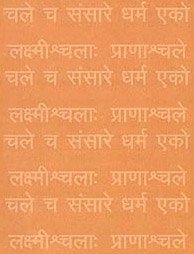
Vedanta (वेदान्त, vedānta) refers to a school of orthodox Hindu philosophy (astika), drawing its subject-matter from the Upanishads. There are a number of sub-schools of Vedanta, however all of them expound on the basic teaching of the ultimate reality (brahman) and liberation (moksha) of the individual soul (atman).
Shaktism (Shakta philosophy)
Source: Google Books: ManthanabhairavatantramSūrya (सूर्य) or Sūryagranthi refers to the “Knot of the Moon (soma)” and represents one of the “sixteen knots” (granthi), according to the Ṣaṭsāhasrasaṃhitā, an expansion of the Kubjikāmatatantra: the earliest popular and most authoritative Tantra of the Kubjikā cult.—Accordingly, “(1) The Knot called Ananta, which is HAṂSA, should be placed (on the body). It is at the middle toe of the sixteen parts (of the body).The Knot of Time is below the ankle. [...] (10) The Knot of the Sun [i.e., sūrya-granthi] is in the navel and (11) the one called the Vital Breath is in its own place (that is, in the breath). [...]”.
The sixteen Knots [i.e., sūrya-granthi] are parts of the goddess’s body. Accordingly, they are projected into the adept’s body to transform it into the Triple Fort, that is, the triangular body of the goddess replete with the energies of the sacred seats. She is both with form, consisting of the letters and mantras, and without form as the Transmental (manonmanī) energy of the god.

Shakta (शाक्त, śākta) or Shaktism (śāktism) represents a tradition of Hinduism where the Goddess (Devi) is revered and worshipped. Shakta literature includes a range of scriptures, including various Agamas and Tantras, although its roots may be traced back to the Vedas.
Ganitashastra (Mathematics and Algebra)
Source: archive.org: Hindu MathematicsSūrya (सूर्य) represents the number 12 (twelve) in the “word-numeral system” (bhūtasaṃkhyā), which was used in Sanskrit texts dealing with astronomy, mathematics, metrics, as well as in the dates of inscriptions and manuscripts in ancient Indian literature.—A system of expressing numbers by means of words arranged as in the place-value notation was developed and perfected in India in the early centuries of the Christian era. In this system the numerals [e.g., 12—sūrya] are expressed by names of things, beings or concepts, which, naturally or in accordance with the teaching of the Śāstras, connote numbers.

Ganitashastra (शिल्पशास्त्र, gaṇitaśāstra) refers to the ancient Indian science of mathematics, algebra, number theory, arithmetic, etc. Closely allied with astronomy, both were commonly taught and studied in universities, even since the 1st millennium BCE. Ganita-shastra also includes ritualistic math-books such as the Shulba-sutras.
Shaivism (Shaiva philosophy)
Source: SOAS University of London: Protective Rites in the Netra TantraSūrya (सूर्य) is the name of a deity described in the Netratantra of Kṣemarāja: a Śaiva text from the 9th century in which Śiva (Bhairava) teaches Pārvatī topics such as metaphysics, cosmology, and soteriology.—Accordingly, [verse 13.17-25ab, while describing the appearance and worship of Sūrya]—“Now, I explain that which consists of light [i.e., Sūrya]. He manifests the siddhi of man. [Sūrya] resembles a red flower, has equal splendor with red juice. [He is] the color of a heap of vermillion, as beautiful as a ruby, appears as the color of safflower . [He] looks like the flower of a pomegranate [and] resembles Soma at the end of time. [Sūrya has] one face, three eyes, four arms, possess a noble nature, and [holds his] hands in the shape of the wish-granting and protection [mudrās]. [...]”.
Note: In 9.5-11, Sūrya is equated with Amṛteśa: “Amṛteśa is supreme. He is free of disease. [...] Because of him, splendid gems light up [differently] under different conditions, giving the fruits of all Āgamas in all streams. Thus, he is Śiva, Sadāśiva, Bhairava, Tumburu, Soma, and Sūrya, with his own form arising bearing no form”.

Shaiva (शैव, śaiva) or Shaivism (śaivism) represents a tradition of Hinduism worshiping Shiva as the supreme being. Closely related to Shaktism, Shaiva literature includes a range of scriptures, including Tantras, while the root of this tradition may be traced back to the ancient Vedas.
Yoga (school of philosophy)
Source: ORA: Amanaska (king of all yogas): A Critical Edition and Annotated Translation by Jason BirchSūrya (सूर्य) refers to the “sun”, according to the Amanaska Yoga treatise dealing with meditation, absorption, yogic powers and liberation.—Accordingly, as Īśvara says to Vāmadeva: “[...] [Now], I shall define the nature of that highest, mind-free absorption which arises for those devoted to constant practice. [...] By means of an absorption for half a day, the light of his own self shines. Just like the sun (sūrya) shines forth with its [own] rays of light, the Yogin shines forth [and illuminates] the world. [...]”.

Yoga is originally considered a branch of Hindu philosophy (astika), but both ancient and modern Yoga combine the physical, mental and spiritual. Yoga teaches various physical techniques also known as āsanas (postures), used for various purposes (eg., meditation, contemplation, relaxation).
General definition (in Hinduism)
Source: Wisdom Library: HinduismSūrya (सूर्य, “the sun”):—One of the five natural forms of Agni (Vedic god of Divine illumination). This form, known as Sūrya, represents the fire of the heavenly sphere which illumines the world, is known as the celestial-fire (divya-agni).
Source: Apam Napat: Indian MythologySurya is the sun. (He is also referred to as Vivasvant) and Martanda. Like Chandra he is both a Deva and a Navagraha. According to the PurushaSuktam[R.V.10.90], he was formed from the eyes of Purusha, the primeaval man, who was sacrificed as an offering to himself. He has two wives Sangya (who is the daughter of Vishwakarma) and Chaaya Devi. He has many children, the most famous of whom is Shani (saturn), who is also one of the Navagrahas. Some sources also say that Yama is a son of Surya.
Among the planets, his enemies are Rahu and Ketu, whose became his enemies in the incident of the churning of the ocean of milk.
Source: WikiPedia: HinduismSūrya (सूर्य): A solar deity who is one of the three main Vedic Gods.
Source: Red Zambala: The Navagrahas — Planetary DeitiesSūrya Nārāyaṇa is the personification of the Sun which is daily worshipped by all Hindus. The Sun is the direct manifestation of the Absolute or Brahman. The physical Sun shares some characteristics posited of Brahman (the Absolute Reality). For example: We speak of the Sun rising, setting being hidden by the clouds etc. In fact he neither raises not sets nor is covered by anything. All of these perceptions of the Sun are conditioned by our time and space bound existence upon earth.
The Sun rides a chariot drawn by 7 horses which are the 7 colours of the spectrum.
Sūrya has four wives:—
- Suvarcala —the Resplendent, illumination or knowledge
- Chāyā — Shade
- Jyoti — Light
- Aiśvarya — Sovereignty
Sūrya (सूर्य) refers to one of the names for the “sun”, who was worshipped as Sūrya, Savitā, Mitra, Pūṣā etc. in the Vedas. Though all of them represented basically the same phenomenon, yet they were considered to be distinct deities as their concepts revealed different powers of the Sun.
In Buddhism
Mahayana (major branch of Buddhism)
Source: Wisdom Library: Maha Prajnaparamita Sastra1) Sūrya (सूर्य) and Candra were two sons of the king of Mithilā according to the Mahāvastu mentioned at a footnote at the 2nd century Mahāprajñāpāramitāśāstra (chapter XXVIII). Accordingly, “Sūrya and Candra were sons of a Brāhman-king of Mithilā (called Jen t’ien, Maṇusyadeva (?) in T 190). The throne becoming vacant, Sūrya gave the kingdom to his brother and became a hermit. But having made the vow not to take anything, even a drop of water that was not given to him, one day he inadvertently violated his vow by drinking the water in the vase of an ascetic. Considering himself to be a thief, he demanded first from his disciples, then from his brother, the punishment he thought he deserved. Candra, in order to please him and to rid him of his scruples made him live for six days in an aśoka forest where he was given the most delicate of food. At the end of six days, he proclaimed a general amnesty that freed Sūrya. Rāhula was at that time Candra, the Buddha was Sūrya”.
2) Sūrya (सूर्य) refers to the “sun” (lighting up the earth), according to Mahāprajñāpāramitāśāstra (chapter 41).—Accordingly, “[Digression on a case brought against the Buddha; B. The defense].—[7. Silence on the Fourteen Difficult Questions].—The Buddha did not answer fourteen difficult questions.—[...] Furthermore, people say: “Nothingness (nāstitva) exists; existence (astitva) does not exist.” They are making a mistake, and the Buddha does not make a mistake by not answering. The sun (sūrya) lights up the earth, but it can neither lower the mountains nor elevate the valleys: it is limited to making them visible. In the same way, the Buddha has no action on dharmas. If they exist, he says that they exist; if they do not exist, he says that they do not exist. Thus he said: [...]”.
Source: academia.edu: A Study and Translation of the GaganagañjaparipṛcchāSūrya (सूर्य) refers to the “sun”, according to the Gaganagañjaparipṛcchā: the eighth chapter of the Mahāsaṃnipāta (a collection of Mahāyāna Buddhist Sūtras).—Accordingly, as Bodhisattva Gaganagañja explains to Bodhisattva Ratnaśrī what kind of concentration should be purified: “[...] (22) [when the Bodhisattvas attain] the concentration called ‘Being endowed with shooting star’ they will overcome all habitual tendencies; (23) [when the Bodhisattvas attain] the concentration called ‘Sunshine’ (sūrya-pradīpa), there will be no darkness; (24) [when the Bodhisattvas attain] the concentration called ‘Turning of the sun’, they will look at the thoughts of all living beings; [...]”.

Mahayana (महायान, mahāyāna) is a major branch of Buddhism focusing on the path of a Bodhisattva (spiritual aspirants/ enlightened beings). Extant literature is vast and primarely composed in the Sanskrit language. There are many sūtras of which some of the earliest are the various Prajñāpāramitā sūtras.
Tibetan Buddhism (Vajrayana or tantric Buddhism)
Source: archive.org: The Indian Buddhist IconographySūrya (सूर्य) or Āditya refers to the Sun-God and represents one of the nine planets (Navagraha), commonly depicted in Buddhist Iconography, and mentioned in the 11th-century Niṣpannayogāvalī of Mahāpaṇḍita Abhayākara.—His Colour is red; his Symbols are the discs of the sun; his Vehicle is the chariot of seven horses.
Āditya (Sūrya) is described in the Niṣpannayogāvalī (dharmadhātuvāgīśvara-maṇḍala) as follows:—
Source: OSU Press: Cakrasamvara Samadhi“Āditya rides on a chariot drawn by seven horses. He is red in colour. Both in the right and in the left he holds the discs of the sun on lotuses”.
[In the Chinese collection, one statuette of this planet [viz., Āditya] occurs under the title of Sūrya].
Sūrya (सूर्य) or “the sun”, is the name of a deity or entity to which is given homage to [i.e., oṃ āṃ sūryāya namaḥ], according to the Guru Mandala Worship (maṇḍalārcana) ritual often performed in combination with the Cakrasaṃvara Samādhi, which refers to the primary pūjā and sādhanā practice of Newah Mahāyāna-Vajrayāna Buddhists in Nepal.
Source: WikiPedia: Tibetan BuddhismSūrya (सूर्य) (in Tibetan: (Wonang) Nyima) (1027–1127 CE) refers to the twelfth of the twenty-five Kalki kings (of Shambhala) who represents the holders of the Kalachakra (“wheel of time”) teachings of Buddha Shakyamuni.—The king Sūrya is described as “all-pervading, radiant jewel light.”.

Tibetan Buddhism includes schools such as Nyingma, Kadampa, Kagyu and Gelug. Their primary canon of literature is divided in two broad categories: The Kangyur, which consists of Buddha’s words, and the Tengyur, which includes commentaries from various sources. Esotericism and tantra techniques (vajrayāna) are collected indepently.
General definition (in Buddhism)
Source: Wisdom Library: Dharma-samgrahaSūrya (सूर्य) refers to the twelfth of the “fourteen world protectors” (caturdaśalokapāla) as defined in the Dharma-saṃgraha (section 10). The Dharma-samgraha (Dharmasangraha) is an extensive glossary of Buddhist technical terms in Sanskrit (e.g., caturdaśalokapāla and Sūrya). The work is attributed to Nagarguna who lived around the 2nd century A.D.
In Jainism
General definition (in Jainism)
Source: Wisdom Library: JainismSūrya (सूर्य) is the shorter name of Sūryadvīpa, one of the continents (dvīpa) of the middle-world (madhyaloka) which is encircled by the ocean named Sūryasamudra (or simply Sūrya), according to Jain cosmology. The middle-world contains innumerable concentric dvīpas and, as opposed to the upper-world (adhaloka) and the lower-world (ūrdhvaloka), is the only world where humans can be born.
Sūrya is recorded in ancient Jaina canonical texts dealing with cosmology and geography of the universe. Examples of such texts are the Saṃgrahaṇīratna in the Śvetāmbara tradition or the Tiloyapannatti and the Trilokasāra in the Digambara tradition.
Source: archive.org: Een Kritische Studie Van Svayambhūdeva’s PaümacariuSūrya (सूर्य) participated in the war between Rāma and Rāvaṇa, on the side of the latter, as mentioned in Svayambhūdeva’s Paumacariu (Padmacarita, Paumacariya or Rāmāyaṇapurāṇa) chapter 57ff. Svayambhū or Svayambhūdeva (8th or 9th century) was a Jain householder who probably lived in Karnataka. His work recounts the popular Rāma story as known from the older work Rāmāyaṇa (written by Vālmīki). Various chapters [mentioning Sūrya] are dedicated to the humongous battle whose armies (known as akṣauhiṇīs) consisted of millions of soldiers, horses and elephants, etc.
Source: archive.org: The Jaina Iconography1) Sūrya (सूर्य) (or Śūrasena, Śivarāja) is the father of Kunthanātha: the seventeenth of twenty-four Tīrthaṃkaras or Jinas, commonly depicted in Jaina iconography.—Kunthanātha’s parent’s names, as may be gathered from the Jaina Purāṇas, are variously called Śūrasena, Sūrya, Śivarāja (Śvetāmbara version) for the father, Śrīkāntā or Śrīdevī for the mother. His father belonged to the Kuru race, and Hastināpura as his capital, where the Jina was born. He, like his predecessor, became an emperor.
2) Sūrya (सूर्य) (the Sun) also represents a deity from the Jyotiṣka-Devas or Navagraha group of deities.—The sun-god (Sūrya) has been described in Śvetāmbara Jainism as riding on a chariot, drawn by seven steeds and holding in his hands two lotuses. He is known there as the deity of the East and the husband of Ratnā-Devī. The Digambara description of the God is simpler.
Source: archive.org: TrisastisalakapurusacaritraSūrya (सूर्य) or Sūryañjaya is the son of king Ratnamālin from Śaśipura, according to the Jain Ramayana and chapter 7.4 [Rāma and Lakṣmaṇa] of Hemacandra’s 11th century Triṣaṣṭiśalākāpuruṣacaritra: an ancient Sanskrit epic poem narrating the history and legends of sixty-three illustrious persons in Jainism.—Accordingly, as Muni Satyabhūti said to king Daśaratha (son of king Anaraṇya): “In East Videhā in the city Śaśipura, the ornament of the north row on Vaitāḍhya, you became the long-armed son, Sūryañjaya, of the Vidyādhara-lord, Ratnamālin, by his wife Vidyullatā. One day Ratnamālin went to the city Siṃhapura to conquer an arrogant Vidyādhara-lord, Vajranayana. He began to burn by force the city Siṃhapura together with its children and old people, its women, its cattle, and gardens [...] ”.
Source: Shodhganga: A cultural study on the jain western Indian illustrated manuscriptsSūrya (सूर्य, “sun”).—The seventh of “fourteen dreams” of Triśalā.—Subsequently Triśalā saw the dazzlingly red Sun, red like kesuda and parrot beak, resembling a lamp in the sphere, the chief of planets, one whom we can only see at the time of its rising and setting, rotating around Meru mountain.
Source: Encyclopedia of Jainism: Tattvartha Sutra 4: The celestial beings (deva)Sūrya (सूर्य, “suns”) refers to a class of “stellar celestial beings” (jyotiṣī), itself a category of devas (celestial beings), according to the 2nd-century Tattvārthasūtra 4.10. Where does the sun revolve? The sun revolves ten yojana above the lowest stars. What is the duration of existence of sun? It is one pit-measured-period (palya) plus one hundred thousand years.
Stellar celestial beings (e.g., Sūrya) are named after their vehicle which is endowed with shining light. These are called by the significant general name luminaries or stellar.
Source: The University of Sydney: A study of the Twelve ReflectionsSūrya (सूर्य) refers to the “Sun”, according to the 11th century Jñānārṇava, a treatise on Jain Yoga in roughly 2200 Sanskrit verses composed by Śubhacandra.—Accordingly, “Rudra, elephants of the quarters, gods, demons, aerial spirits, aquatic predators, the planets, the Vyantaras , the guardians of the quarters of the sky, the enemies [of Vāsudeva], Hari, Bala, the chief of the snakes, the lord of the discus (i.e. Viṣṇu) and others who are powerful, the wind, the sun [com.—sūrya—‘the sun’], etc. all themselves having come together are not able to protect an embodied soul even for an instant [when death is] initiated by the servants of Yama”.
Synonyms: Aryaman, Arka.

Jainism is an Indian religion of Dharma whose doctrine revolves around harmlessness (ahimsa) towards every living being. The two major branches (Digambara and Svetambara) of Jainism stimulate self-control (or, shramana, ‘self-reliance’) and spiritual development through a path of peace for the soul to progess to the ultimate goal.
India history and geography
Source: Project Gutenberg: Castes and Tribes of Southern India, Volume 11) Surya (“sun”) or Arka is one of the exogamous septs (divisions) among the Komatis (a trading caste of the Madras Presidency). The Komatis are said to have originally lived, and still live in large numbers on the banks of the Godavari river. One of the local names thereof is Gomati or Gomti, and the Sanskrit Gomati would, in Telugu, become corrupted into Komati. The sub-divisions are split up into septs (viz., Surya), which are of a strictly exogamous character.
2) Surya (“sun”) is one of the exogamous septs (divisions) among the Kurubas (a tribe of South India). The Kurubas are sub-divided into clans or gumpus, each having a headman or guru called a gaudu, who gives his name to the clan. And the clans are again sub-divided into gotras or septs (viz., Surya).
Source: Cologne Digital Sanskrit Dictionaries: Indian Epigraphical GlossarySūrya.—(IE 7-1-2; EI 25), ‘twelve’. Note: sūrya is defined in the “Indian epigraphical glossary” as it can be found on ancient inscriptions commonly written in Sanskrit, Prakrit or Dravidian languages.

The history of India traces the identification of countries, villages, towns and other regions of India, as well as mythology, zoology, royal dynasties, rulers, tribes, local festivities and traditions and regional languages. Ancient India enjoyed religious freedom and encourages the path of Dharma, a concept common to Buddhism, Hinduism, and Jainism.
Languages of India and abroad
Marathi-English dictionary
Source: DDSA: The Molesworth Marathi and English Dictionary1) Sūrya (सूर्य).—m (S) The sun. 2 The sun personified as a god. Pr. sūryāpuḍhēṃ kāḍavāta; sūryāpuḍhēṃ kājavā. sūryācē āḍa In the sunshine. sūryācē ghōḍē or sūryācīṃ hariṇēṃ or pilēṃ dākhaviṇēṃ To lift up (a child) by his ears; or to raise him by pressing the sides of the head, rubbing the thumb forcibly along his crown; to show London. Also samudra dākhaviṇēṃ, kāśīcī vāṭa dākhaviṇēṃ, bōrīsa bōrēṃ āṇaṇēṃ, and similar phrases. hā sūrya āṇi hā jayadratha This is the hour, and here's the man! Behold the conjunction of the two particulars required!
2) suṛyā (सुऋया).—m A vessel drilled with holes. Boiled flour is pressed through them into strings or rolls like kuraḍaī (pl kuraḍyā) or vermicelli.
3) suṛyā (सुऱ्या).—a (sūra) That sings second with. See sūrakarī.
Source: DDSA: The Aryabhusan school dictionary, Marathi-Englishsūrya (सूर्य).—m The sun. hā sūrya āṇi hā jayadratha This is the hour and this is the man! Be- hold the conjunction of the two particulars required.
Marathi is an Indo-European language having over 70 million native speakers people in (predominantly) Maharashtra India. Marathi, like many other Indo-Aryan languages, evolved from early forms of Prakrit, which itself is a subset of Sanskrit, one of the most ancient languages of the world.
Sanskrit dictionary
Source: DDSA: The practical Sanskrit-English dictionarySūrya (सूर्य).—[sarati ākāśe sūryaḥ, yadvā suvati karmaṇi lokaṃ prerayati; cf. Sk. on P.III.1.114]
1) The sun; सूर्ये तपत्यावरणाय दृष्टेः कल्पेत लोकस्य कथं तमिस्रा (sūrye tapatyāvaraṇāya dṛṣṭeḥ kalpeta lokasya kathaṃ tamisrā) R.5.13. [In mythology, the sun is regarded as a son of Kaśyapa and Aditi. He is represented as moving in a chariot drawn by seven horses, with Aruṇa for his charioteer. He is also represented as all-seeing, the constant beholder of the good and bad deeds of mortals. Samjñā (or Chhāyā or Aśvinī) was his principal wife, by whom he had Yama and Yamunā, the two Aśvins and Saturn. He is also described as having been the father of Manu Vaivasvata, the founder of the solar race of kings.]
2) The tree called Arka.
3) The number 'twelve' (derived from the twelve forms of the sun).
4) The swallow-wort.
5) Name of Śiva.
Derivable forms: sūryaḥ (सूर्यः).
--- OR ---
Sūryā (सूर्या).—
1) The wife of the sun.
2) The daughter of the sun.
3) The hymn about the marriage of Śūryā.
4) a new bride.
5) A drug.
6) The colocynth.
Source: Cologne Digital Sanskrit Dictionaries: Edgerton Buddhist Hybrid Sanskrit DictionarySūrya (सूर्य).—(1) name of a prince of Mithilā: Mahāvastu iii.172.9 ff.; (2) name of a Śākyan youth: Avadāna-śataka i.381.1 ff.; (3) name of a yakṣa: Mahā-Māyūrī 236.16 and 25.
Source: Cologne Digital Sanskrit Dictionaries: Shabda-Sagara Sanskrit-English DictionarySūrya (सूर्य) or Sūryya.—m.
(-ryaḥ) 1. The sun. 2. Gigantic swallow wort, (Asclepias gigantea.) 3. The son of Bali. f.
(-ryā) 1. The wife of the sun. 2. A bittergourd. 3. A new bride. E. sṛ to go, (in the heavens,) kyap aff., form irr.
Source: Cologne Digital Sanskrit Dictionaries: Benfey Sanskrit-English DictionarySūrya (सूर्य).—i. e. 2. svar, or rather *savar (for original *savan), + ya, I. m. 1. The sun, [Pañcatantra] 37, 20. 2. Gigantic swallow-wort. 3. The sen of Bali. Ii. f. yā. 1. The wife of the sun. 2. A new bride. 3. A bitter gourd.
Source: Cologne Digital Sanskrit Dictionaries: Cappeller Sanskrit-English DictionarySūrya (सूर्य).—[masculine] the sun or its deity; [feminine] sūryā the Sun personified as a female, a cert. hymn of the Rigveda.
Source: Cologne Digital Sanskrit Dictionaries: Aufrecht Catalogus Catalogorum1) Sūrya (सूर्य) as mentioned in Aufrecht’s Catalogus Catalogorum:—one of the gurus of Ṣaḍguruśiṣya. W. p. 12.
2) Sūrya (सूर्य):—son of Jñānarāja, brother of Cintāmaṇi:
—[commentary] on Śrīpati’s Jātakapaddhati.
—[commentary] Sūryaprakāśa on Bhāskara’s Bījagaṇita, written in 1539.
Sūrya has the following synonyms: Sūryadāsa.
Source: Cologne Digital Sanskrit Dictionaries: Monier-Williams Sanskrit-English Dictionary1) Surya (सुर्य):—[from surā] mfn., [Patañjali on Pāṇini 5-1, 1], [vArttika] 4.
2) Sūrya (सूर्य):—[from sūr] a m. the sun or its deity (in the Veda the name Sūrya is generally distinguished from Savitṛ [q.v.], and denotes the most concrete of the solar gods, whose connection with the luminary is always present to the poet’s mind ; in [Nirukta, by Yāska vii, 5] he is regarded as one of the original Vedic triad, his place being in the sky, while that of Agni is on the earth, and that of Indra is in the atmosphere; ten hymns in the [Ṛg-veda] are entirely in praise of Sūrya e.g. [i, 50, i, 115 etc.], also, [Atharva-veda xiii, 2]; he moves through the sky in a chariot drawn by seven ruddy horses or mares [see saptāśva, harit, harid-aśva]; in the later mythology Sūrya is identified with Savitṛ as one of the 12 Ādityas or emblems of the Sun in the 12 months of the year, and his seven-horsed chariot is said to be driven by Aruṇa or the Dawn as its charioteer, who is represented without legs; the Sun, whether named Sūrya or Vivasvat, has several wives See sūryā below), [Ṛg-veda] etc. etc. (cf. [Indian Wisdom, by Sir M. Monier-Williams 11; 16 etc.; Religious Thought and Life in India 341])
3) [v.s. ...] a symbolical expression for the number ‘twelve’ (in allusion to the sun in the 12 signs of the zodiac), [Jyotiṣa; Hemādri’s Caturvarga-cintāmaṇi]
4) [v.s. ...] the swallow-wort (either Calotropis or Asclepias Gigantea, = arka), [cf. Lexicographers, esp. such as amarasiṃha, halāyudha, hemacandra, etc.]
5) [v.s. ...] Name of the son of Bali, [cf. Lexicographers, esp. such as amarasiṃha, halāyudha, hemacandra, etc.]
6) [v.s. ...] of a Dānava, [Vahni-purāṇa]
7) [v.s. ...] of an astronomer (= sūrya-dāsa), [Catalogue(s)]
8) [v.s. ...] epithet of Śiva, [Mahābhārata]
9) Sūryā (सूर्या):—[from sūrya > sūr] a f. the wife of Sūrya or the Sun (also called Saṃjñā, q.v.)
10) [v.s. ...] the daughter of Sūrya or the Sun (See, [Ṛg-veda i, 116, 17]; also described as daughter of Prajāpati or of Savitṛ and wife of the Aśvins, and in other places as married to Soma; in [Ṛg-veda i, 119, 2] she is called Ūrjānī, and in [vi, 55, 4, vi, 58, 4] the sister of Pūṣan q.v., who is described as loving her, and receiving her as a gift from the gods; [according to] to some she represents a weak manifestation of the Sun; Sūryā Sāvitrī is regarded as the authoress of the Sūryā-sūkta, [Ṛg-veda x, 85]), [Ṛg-veda; Atharva-veda; Aitareya-brāhmaṇa; Kauśika-sūtra]
11) [v.s. ...] = vāc, [Naighaṇṭuka, commented on by Yāska i, 11]
12) [v.s. ...] = sūryā-sūktā (q.v.), [Śāṅkhāyana-gṛhya-sūtra]
13) [v.s. ...] a new bride
14) [v.s. ...] a drug, [cf. Lexicographers, esp. such as amarasiṃha, halāyudha, hemacandra, etc.]
15) [v.s. ...] the colocynth or bitter gourd, [cf. Lexicographers, esp. such as amarasiṃha, halāyudha, hemacandra, etc.]
16) Sūrya (सूर्य):—[from sūr] mfn. solar (perhaps [wrong reading] for saurya), [Jyotiṣa][For cognate words See under 2. svar.]
17) Sūryā (सूर्या):—[from sūr] b f. See sūrya above.
18) Sūrya (सूर्य):—b etc. See p.1243, [column] 1.
Source: Cologne Digital Sanskrit Dictionaries: Yates Sanskrit-English DictionarySūrya (सूर्य):—(ryyaḥ) 1. m. The sun; gigantic swallow wort; son of Bali. 1. f. Sun’s wife; new bride; bitter gourd.
Source: DDSA: Paia-sadda-mahannavo; a comprehensive Prakrit Hindi dictionary (S)Sūrya (सूर्य) in the Sanskrit language is related to the Prakrit words: Tujja, Sujja, Sūra.
[Sanskrit to German]
Sanskrit, also spelled संस्कृतम् (saṃskṛtam), is an ancient language of India commonly seen as the grandmother of the Indo-European language family (even English!). Closely allied with Prakrit and Pali, Sanskrit is more exhaustive in both grammar and terms and has the most extensive collection of literature in the world, greatly surpassing its sister-languages Greek and Latin.
Hindi dictionary
Source: DDSA: A practical Hindi-English dictionarySūrya (सूर्य) [Also spelled sury]:—(nm) the sun; ~[kara/raśmi] rays (of the sun); ~[kāṃta] the jasper; ~[keṃdrīya] heliocentric; ~[grahaṇa] solar eclipse; —[ghaḍī] a sun-dial; ~[citrika] heliograph; ~[citrīya] heliographic; ~[tanayā/naṃdinī/putrī] an epithet of the river Yamuna:, -[parimaṃḍala] corona of the sun; ~[pūjā] heliolatry; -[prabhā] sunlight; -[biṃba/maṃḍala] the orb or disc of the sun; ~[maṇi] the jasper; ~[mukhī] the sunflower—Helianthus annus; having the colour of the skin rendered white (through disease); ~[vaṃśa] a celebrated ancient Indian dynasty of Kshatriya kings; ~[vaṃśī] one belonging to the solar dynasty ([sūryavaṃśa] ).
...
Kannada-English dictionary
Source: Alar: Kannada-English corpusSūrya (ಸೂರ್ಯ):—
1) [noun] the sun.
2) [noun] the Sun-God.
3) [noun] the plant Calotropis gigantea (var. albiflora) of Asclepiadaceae faily.
4) [noun] a particular esoteric hymn.
5) [noun] (math.) a symbol for the number twelve.
6) [noun] (ಸೂರ್ಯ [surya]) ಪಶ್ಚಿಮದಲ್ಲಿ ಹುಟ್ಟು [pashcimadalli huttu] (sūrya) paścimadalli huṭṭu (prov.) something that is against the nature’s rule or is extremely unusual; ಸೂರ್ಯನಿಗೆ ಸೊಡರನ್ನು ಇಡು [suryanige sodarannu idu] sūryanige soḍarannu iḍu (fig.) to try to help arrogantly a person or cause without realising one’s inability or limitations to do so; ಸೂರ್ಯನ ಮೇಲೆ ಮಣ್ಣು ತೂರಿದರೆ ಮೋರೆ ಮೇಲೆ ಬೀಳುವುದು [suryana mele mannu turidare more mele biluvudu] sūryana mēle maṇṇu tūridare mōre mēle bīḷuvudu (prov.) if he spits on the heaven, it falls on his face.
Kannada is a Dravidian language (as opposed to the Indo-European language family) mainly spoken in the southwestern region of India.
See also (Relevant definitions)
Starts with (+423): Shuryakarna, Suriyakhara, Surya daivajna, Surya kavi, Surya pandita, Surya pattra, Surya suri, Surya-bha, Surya-kantha, Surya-siddhanta, Surya-varti, Suryabali, Suryabali rama, Suryabalirama, Suryabamdhu, Suryabhaga, Suryabhakta, Suryabhaktaka, Suryabhanu, Suryabhas.
Ends with (+35): Abhisurya, Aishyatsurya, Aparasurya, Apasuriya, Asurya, Atisurya, Balasurya, Balsurya, Candrasurya, Caturvaktra-Surya, Daivayajnapanditasurya, Daivayajnapindasurya, Didhitisurya, Durasurya, Dvisurya, Jalasurya, Jinasurya, Jnanasurya, Jyotisurya, Kalasurya.
Full-text (+1093): Suryasta, Suryamandala, Suryashman, Suryatanaya, Suryahva, Suryaloka, Suryasukta, Suryalata, Suriya, Aruna, Suryamani, Asuryampashya, Suryavasu, Suryashva, Suryavid, Suryagraha, Suryakala, Suryakanti, Asuryam, Suryatapa.
Relevant text
Search found 202 books and stories containing Surya, Sūrya, Sūryā, Shurya, Śūrya; (plurals include: Suryas, Sūryas, Sūryās, Shuryas, Śūryas). You can also click to the full overview containing English textual excerpts. Below are direct links for the most relevant articles:
Rig Veda (translation and commentary) (by H. H. Wilson)
Brihad Bhagavatamrita (commentary) (by Śrī Śrīmad Bhaktivedānta Nārāyana Gosvāmī Mahārāja)
Verse 2.3.20-21 < [Chapter 3 - Bhajana (loving service)]
Verse 2.3.41 < [Chapter 3 - Bhajana (loving service)]
Verse 1.5.93 < [Chapter 5 - Priya (the beloved devotees)]
Puranic encyclopaedia (by Vettam Mani)
Vedic influence on the Sun-worship in the Puranas (by Goswami Mitali)
Part 5 - Sūrya (the Healer) < [Chapter 2 - Salient Traits of the Solar Divinities in the Veda]
Part 2 - Sūrya (The God of Atmosphere) < [Chapter 2 - Salient Traits of the Solar Divinities in the Veda]
Part 29 - Rohita (the generator of the universe) < [Chapter 2 - Salient Traits of the Solar Divinities in the Veda]
Women in the Atharva-veda Samhita (by Pranab Jyoti Kalita)
24. Goddess Sūryā < [Chapter 4 - Female Deities and the Glorification of Women in the Atharvaveda]
3. Hymn to Obtain a Wife < [Chapter 2 - The Strīkarmāṇi Hymns of the Atharvaveda]
3. Goddess Asunīti < [Chapter 4 - Female Deities and the Glorification of Women in the Atharvaveda]
Garga Samhita (English) (by Danavir Goswami)
Verse 6.9.13 < [Chapter 9 - The Arrival of Śrī Dvārakā]
Verse 4.1.11 < [Chapter 1 - The Story of the Personified Vedas]
Verse 4.15.21 < [Chapter 15 - The Story of the Women of Barhiṣmatī-pura, the Apsarās, and the Women of Sutala and Nāgendra]
Related products
(+6 more products available)
